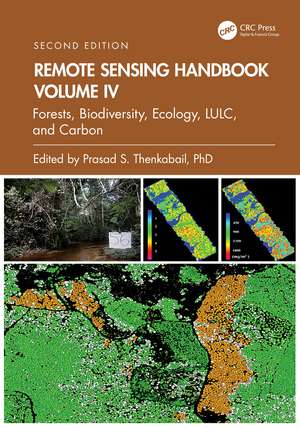Remote Sensing Handbook, Volume IV: Forests, Biodiversity, Ecology, LULC, and Carbon: Remote Sensing Handbook
Editat de Prasad S. Thenkabailen Limba Engleză Hardback – 29 noi 2024
FEATURES
- Provides the most up-to-date comprehensive coverage of remote sensing science for forests, biodiversity, land cover and land use change (LCLUC), biomass, and carbon.
- Discusses and analyzes data from old and new generations of satellites and sensors spread across 60 years.
- Extensive forestry, LCLUC studies, biomass, and carbon using optical, radar, LiDAR, and hyperspectral data.
- Includes numerous case studies on advances and applications at local, regional, and global scales.
- Introduces advanced methods in remote sensing such as machine learning, cloud computing, and AI.
- Highlights scientific achievements over the last decade and provides guidance for future developments.
Preț: 1133.50 lei
Preț vechi: 1382.31 lei
-18% Nou
Puncte Express: 1700
Preț estimativ în valută:
216.89€ • 226.47$ • 179.10£
216.89€ • 226.47$ • 179.10£
Carte tipărită la comandă
Livrare economică 15-29 aprilie
Preluare comenzi: 021 569.72.76
Specificații
ISBN-13: 9781032891033
ISBN-10: 1032891033
Pagini: 550
Ilustrații: 260
Dimensiuni: 178 x 254 mm
Greutate: 1.15 kg
Ediția:2
Editura: CRC Press
Colecția CRC Press
Seria Remote Sensing Handbook
ISBN-10: 1032891033
Pagini: 550
Ilustrații: 260
Dimensiuni: 178 x 254 mm
Greutate: 1.15 kg
Ediția:2
Editura: CRC Press
Colecția CRC Press
Seria Remote Sensing Handbook
Public țintă
Postgraduate, Professional Reference, and Undergraduate AdvancedCuprins
Part I: Forests. 1. Characterizing Tropical Forests with Multispectral Imagery. 2. Remote Sensing of Forests from Lidar and Radar. 3. Forest Biophysical and Biochemical Properties from Hyperspectral and LiDAR Remote Sensing. 4. Optical Remote Sensing of Tree and Stand Heights. Part II: Biodiversity. 5. Biodiversity of the World: A Study from Space. 6. Multi-scale Habitat Mapping and Monitoring using Satellite Data and Advanced Image Analysis Techniques. Part III: Ecology. 7. Ecological Characterization of Vegetation Using Multi-Sensor Remote Sensing in the Solar Reflective Spectrum. Part IV: Land Use/Land Cover. 8. Land Cover Change Detection. 9. Land Use and Land Cover Mapping and Monitoring wirh Radar Remote Sensing. V: Carbon. 10. Global Carbon Budgets and the Role of Remote Sensing. 11. Above-ground Terrestrial Biomass and Carbon Stock Estimations from Multi-sensor Remote Sensing. Part VI: Summary and Synthesis of Volume IV. 12. Remote Sensing Handbook, Volume IV: Forests, Biodiversity, Ecology, LULC and Carbon.
Notă biografică
Dr. Prasad S. Thenkabail, Senior Scientist (ST), United States Geological Survey (USGS), is a world-recognized expert in remote sensing science with major contributions in the field for nearly 40 years. He has made the list of the world’s top 1% of scientists across 22 scientific fields and 176 sub-fields. Dr. Thenkabail has conducted pioneering research in hyperspectral remote sensing of vegetation, global croplands, and their water use for food security. He obtained his PhD from the Ohio State University in 1992 and has 168 peer-reviewed publications including 15 books, including this six-volume set, and over 15 major data releases such as the Landsat-derived global cropland extent product @ 30m and Landsat-derived rainfed and irrigated cropland area product @ 30 m (LGRIP30). He was recognized as a Fellow of the American Society of Photogrammetry and Remote Sensing (ASPRS) in 2023. His scientific papers have won several awards for demonstrating world-class, highest-quality research. He was a Landsat Science Team Member (2007-2011).
Descriere
Volume IV of the Remote Sensing Handbook, Second Edition, is focused on the use of remote sensing in forestry, biodiversity, ecology, land use and land cover, and global terrestrial carbon mapping and monitoring. This book is an essential resource for researchers at all levels interested in using remote sensing.









